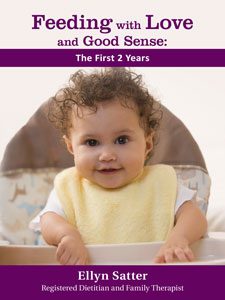

Family Meals Focus
The Ellyn Satter Institute Newsletter
Toddler feeding: A series of unfortunate events
by Ellyn Satter, Registered Dietitian and Family Therapist
The toddler stage in feeding can make or break your raising a child to be a good eater. Toddlers act really picky. They don’t eat much, eat a lot some days and virtually nothing the next, and snub food that they have eaten many times before. They carry on continual skirmishes to test your doing your jobs with feeding. Now is the time to establish the division of responsibility in feeding, if you haven’t already. Correct feeding problems now, while they are small and the adjustments are minor. Problems don’t go away on their own, and get worse and worse as your child gets into the preschool, school-age, and even teenage years.
The toddler stage is full of pitfalls
The whole situation is a setup for parents: the toddler’s food intake drops off as she grows more slowly than before, develops mentally enough to become skeptical of new food, and tests limits by refusing to eat meals and then begging for food handouts between meal- and snack-times. You will dig holes for yourself in feeding your toddler, with her enthusiastic assistance, by limiting menus to foods she readily accepts, by playing games to get her to eat, and by leaving out little food dishes for her to graze on when she cruises by. None of it works because it isn’t developmentally appropriate. With feeding as in other ways, it is time for the toddler to learn to be part of the family.1
Toddlers must have structure
You will dig holes for yourself in feeding your toddler, with her enthusiastic assistance.
Include your toddler in family meals and sit-down snacks at predictable times, let her determine what and how much to eat from what you provide, and don’t short-order cook for her or let her panhandle for food or beverages between times, except for water. Don’t ask her what she wants to eat, she doesn’t know and she isn’t mature enough to even think about it. In fact, she is far too busy to know she is even hungry until she collapses, so waiting to feed her until she asks is a big mistake. Plan menus to be considerate of your toddler’s limitations with chewing, swallowing, and food acceptance, but don’t cater to her likes and dislikes. Time snacks so she can come to meals hungry but not famished and ready to explore the food there.”,1,2
Adventures in feeding toddlers
Parents attempt to follow this advice, get pulled in by toddlers’ erratic eating behavior, and create any number of struggles around feeding. Uncorrected, those struggles distort the feeding relationship, undermine the child’s eating competence, and persist into later life. Consider the toddler who hasn’t the slightest interest in eating solid food and learning how to eat table food. Consider the toddler falling off his growth curve, who shows little or no interest in the high-fat food his parents try to get him to eat, instead preferring to eat fruit and grains. Consider the toddler who sings a little song, over and over, “I’m hungry,” “m hungry,” “I’m hungry.”
References
Explore
Feeding with Love and Good Sense: The First Two Years 2020 Gives a brief and clear road map in words and pictures for navigating your child's early months. Sections about child development and temperament and step-by-step guidance on how and what to feed help you understand your child and guide feeding based on information coming from them. Newly introduced sections give guidance to parents on managing family meals: family-friendly meals, being considerate without catering with food selection, and using "forbidden" food.
To see what good feeding looks like as well as to read about it, see Ellyn Satter’s Feeding with Love and Good Sense DVD II. For the home use version, click here.


